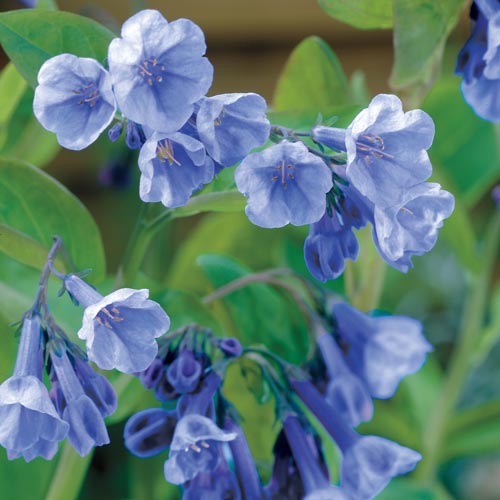Mystical Beauty of the Virginia Bluebell
Virginia Bluebell's Rich History Rooted in Nature
Virginia Bluebell's flowers marked spring’s full awakening for certain Native American tribes but represented tranquility and renewal to others. The beauty of these plants enchanted early settlers who then moved them to cottage gardens to establish their role in ornamental horticulture.
This plant became highly popular throughout Europe during the Victorian era as gardeners looked for enchanting beauty in shaded woodland garden beds. Wealthy estate owners grew these plants in their gardens because they loved their dreamy colors and elegant growth habits. Naturalized gardens now showcase this species as a valued feature while conservation initiatives focus on protecting native plant populations.
Early Medicinal Uses and Healing Properties
Healers and herbalists began exploring its medicinal properties when they first encountered this wildflower. Indigenous tribes became the earliest practitioners to use the plant's properties for healing by preparing remedies from its various parts to treat common medical conditions. People thought it possessed mild astringent properties which helped treat wounds and decrease inflammation. The leaves of this plant were brewed into teas to help people with respiratory problems and its roots created poultices for sore muscles and small wounds.
The discovery of its medicinal benefits led early American herbalists to conduct more extensive experiments. Various reports indicate that this particular treatment was used for digestive issues but there is little concrete evidence to support its effectiveness. This plant has been replaced by better-researched alternatives in modern herbal medicine but its historical applications reveal the ingenuity of ancient healers who utilized natural resources.
Virginia Bluebell is A Woodland Jewel in Landscaping
Virginia Bluebell stands out as one of the most elegant botanical choices for shaded gardens and natural landscapes. The plant finds its ideal growing conditions in rich soil with high moisture content that allows it to spread over time and create thick colorful patches near trees and along streams. This plant finds its place in shaded perennial borders because its vibrant blooms create stunning contrasts with ferns and hostas among other spring ephemerals.
The plant's top value in landscaping comes from how it merges effortlessly with naturalized environments. The plant harmonizes with early-blooming native species to produce displays featuring soft blue, purple and pink hues. When temperatures rise the plant's foliage retreats gracefully to give way to late-season perennials which dominate the landscape. Woodland restoration projects benefit from this plant because it naturally establishes itself without threatening native plant populations.
A Glimpse Into Its Enchanting Appearance
This wildflower captures attention through its constantly evolving aesthetic appeal. The plant's foliage develops from the soil into a soft silvery-green color that shows a subtle shimmer. Throughout the growing season delicate bell-shaped flowers appear first as pale pink buds which eventually change into a stunning sky-blue shade. The flower's color change enhances its mysterious allure, which draws both human and insect visitors.

Multiple blossoms rest on slender, arching stems which produce a graceful cascade that adds to its woodland appeal. Graceful blooms sway softly in the wind which creates an otherworldly atmosphere in their environment. Their subtle movements together with their vibrant colors establish these flowers as among spring's most enchanting wildflowers.
The Rare Wildlife Virginia Bluebell Lures In
This beautiful plant serves as both a visual gem and a crucial food source for spring pollinators. The plant draws bumblebees among its most regular visitors because they excel at gathering nectar from its bell-shaped flowers. Bumblebees stand out from other bees because they have the necessary power and skill to reach the sweet nectar found deep inside each flower.
The hummingbird moth serves as another significant visitor to the plant because it gracefully hovers to drink nectar and resembles its namesake bird yet many people overlook it as a pollinator. These moths appear infrequently in gardens so their host plant becomes essential to anyone wishing to lure them.
Virginia Bluebell functions not only to support pollinators but also provides essential nourishment for specific caterpillars that depend on its foliage during their developmental stages. The relationship between this plant and native wildlife highlights its crucial role in sustaining ecosystem health where habitat destruction has reduced pollinator numbers.
A Timeless Symbol of Spring’s Awakening
This wildflower's appeal exceeds the beauty of its petals and its environmental advantages. This blossom represents enduring symbols that embody renewal alongside resilience and transient beauty. When it emerges as one of the earliest spring blooms, it marks the seasonal transition and restores warmth and vitality to the landscape after a period of winter dormancy.
The fleeting existence of Virginia Bluebell highlights nature's fine balance and prompts both gardeners and conservationists to protect it for future generations. This plant maintains its captivating elegance and grace whether it grows in shaded garden beds, along quiet stream banks, or throughout forest understories. This species represents an invaluable woodland treasure for admirers of native plant beauty who should regard it with protection and esteem.